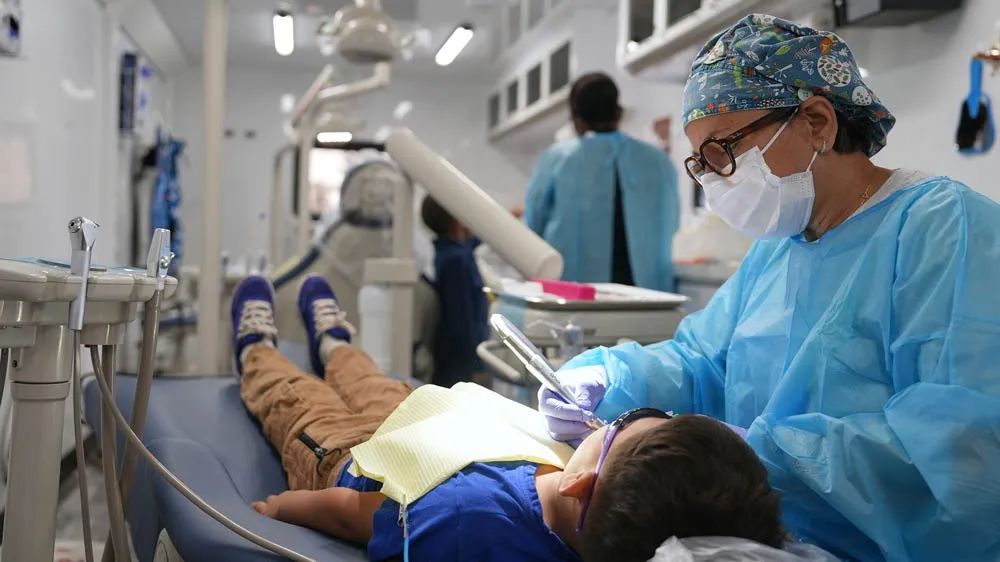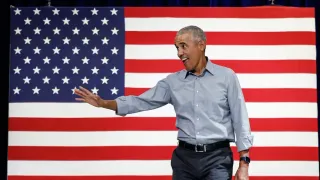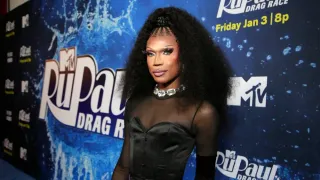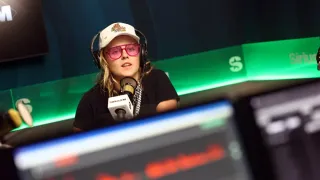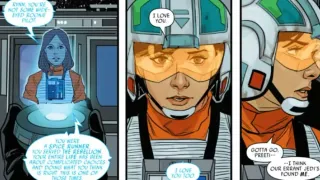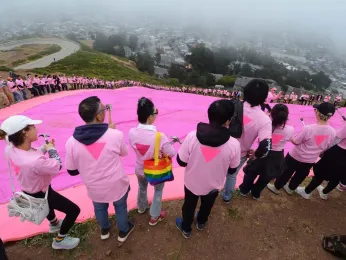
Jun 9
SF pink triangle display marks 30 years
David-Elijah Nahmod READ TIME: 7 MIN.
Celebrating Pride Month and learning about a dark chapter of world history has, since 1996, been a tradition in San Francisco. That was again the case Saturday, June 7, when several hundred people made the trek to the top of Twin Peaks for the 30th installation of the pink triangle on a hillside facing the city’s LGBTQ Castro district and downtown.
But the ceremony also delved into current events that many in the LGBTQ community and allies consider equally dangerous due to policies implemented by Republican President Donald Trump and his administration.
San Francisco Pride Executive Director Suzanne Ford, a trans woman, referenced anti-trans legislation in states around the country and Trump’s executive orders that take aim at trans people, including a ban on military service and an executive order “defending women from gender ideology.”
"We look forward to the day when we will be liberated from this MAGA regime," Ford said. "This year on Pride Sunday, as we recommit to liberating our people, coming to Pride this year is a revolutionary act."
This year’s Pride theme is “Queer Joy is Resistance.”
District 8 Supervisor Rafael Mandelman referred to himself as "the very pink, very gay, president of the Board of Supervisors."
"Happy Pride, everyone!" he proclaimed. He referred to this year as a "weird" Pride, what with a hostile federal administration trying to erase the late gay San Francisco supervisor Harvey Milk. Mandelman was referring to reports that Defense Secretary Pete Hegseth will strip a navy vessel of Milk’s name.
"I am so grateful that I live in a city and a state that recognizes and celebrates not just Harvey Milk but all of our amazing queer ancestors, leaders, folks who helped change the world," Mandelman said.
San Francisco Mayor Daniel Lurie appreciated the milestone year for the pink triangle and also mentioned the changed national climate.
"Congratulations on the 30-year pink triangle commemoration," Lurie said. "Here, on this hill, San Francisco has transformed it into a beacon of Pride. A call to remember, a call to resist, and a call to love, openly, defiantly, and without apology. Thank you to all of the volunteers here today.
“This year, as we face a national rise in anti-LGBTQ+ rhetoric and legislation, the pink triangle takes on an even deeper meaning,” the mayor added. “It reminds us that silence is not an option. That San Francisco must continue to be loud, to lead with action, compassion and pride. We will fund health care for trans San Franciscans, we will protect LGBT youth from hate. To the LGBT elders who survived persecution, this triangle is for you. To the artists and activists who made beauty out of pain, this triangle is for you. To the trans and queer youth still finding their voice, this triangle is for you.”
Referring to Milk’s mantra of giving people hope, Lurie noted, “Today from the top of Twin Peaks, hope is louder than ever. Happy Pride, San Francisco, let's keep shining."
Many in attendance were volunteers who arrived early that morning to install the bright pink tarps. For co-founder Patrick Carney, it was quite the achievement.
"I had no expectation I'd be working on a 30th pink triangle of Twin Peaks," Carney, a gay man, said in an interview with the Bay Area Reporter. "The first one was done rather spontaneously just to add some color to the Pride parade and to spread the celebration to the other end of Market Street so those in the parade would be marching toward the pink triangle atop Twin Peaks.
“It was only afterward that it became apparent many people didn't know what it really meant, some thought it was just another colorful symbol to represent the LGBTQ+ community,” Carney added. “That is why the project continued and why the commemoration ceremonies were introduced, to teach the lessons of the Pink Triangle."
Educational tool
That lesson was that the pink triangle symbol was used by the Nazis at the concentration camps during World War II to brand suspected homosexuals. Similar symbols, such as a Star of David for Jewish prisoners, marked others who were imprisoned, millions of whom died at the camps during the Holocaust. Much later, the pink triangle was reclaimed by the LGBTQ community as a symbol of empowerment.
Carney said that he was elated to have reached this anniversary.
"It is actually quite gratifying and rewarding that so many people are still interested in helping to construct this giant warning and reminder of what extreme hatred can lead to," he said. "There have probably been 10,000-plus volunteers over the decades. This is a massive community building project and a giant in-your-face educational tool to teach people of what can happen if we don't remain vigilant."
The B.A.R. also spoke to some of the volunteers.
"The pink triangle is such a huge symbol for the start of Pride for the entire Bay Area," said Britnee Barnes, 35, a bisexual woman. "I think it's important to us because it takes a previously negative symbol of our community and turns it into something positive. I'm so happy to be here. It's so important that our community comes together, especially in these political times. It's a reminder that we're all as one."
The commemoration ceremony, which took place at 10:30 a.m., featured a variety of speakers in addition to Ford, Mandelman, and Lurie. Gay state Senator Scott Wiener (D-San Francisco), spoke, as did Carney, among others. Tammy Sandhu, an ally who is the British consul general in San Francisco, was a special guest, and there was a musical performance from lesbian chanteuse Leanne Borghesi, accompanied by the San Francisco Pride Band. It was a chilly morning, but the crowd was upbeat, listening to the speeches in rapt attention and applauding. Many of the speakers touched upon the current political landscape and Trump’s anti-LGBTQ, anti-immigration policies.
"Part of any Pride is knowing where we've been," said Carney, speaking from the podium. "And this pink triangle is exactly where we've been, and it's more important than ever these days, after what's going on in D.C. Personal freedoms, free speech, even due process and habeas corpus are under attack from the current administration. The transgender community, drag queens and even Pride celebrations themselves are being targeted.”
Before the other speakers took to the microphone, there was a blessing from Sister Vina Sinfurrs of the drag nun philanthropic group Sisters of Perpetual Indulgence.
"Blessed be this pink triangle, a symbol of hate and fear transformed into a symbol of Pride and power," Sinfurrs said, in part. "Blessed be St. Patrick the Pink, instigator of this mighty tradition, and his noble band of twelve thousand helpers, we all count on the helpers, let’s all be helpers. Blessed be all those in need everywhere, and blessed be the helpers, blessed be diversity, equity and inclusion, what the hell is wrong with that?"
The audience applauded the sister's words, and Sandhu spoke.
"The pink triangle was first used by the Nazis in concentration camps to identify and persecute the thousands of gay men who were imprisoned by the regime," Sandhu said, recalling the history. "This symbol, which had first been used as a label to stigmatize, has since been embraced by the gay community as a symbol of Pride, of defiance and of memory. But in the 1930s and 1940s there was nothing to celebrate. Triangles of various colors were used to identify each category, and I quote, ‘undesirables.’ Gay men were forced to wear the pink triangle on their pockets in concentration camps as homosexuals to identify them and to set them apart from their fellow prisoners."
Sandhu pointed out that 60% of the gay men held by the Nazis were killed.
"It's the same kind of irrational, senseless hatred that haunts us today," she said. “So, prejudice is not just historic, it is contemporary, it is still with us today, both abroad and closer to home. That is why the Twin Peaks pink triangle is so vitally important."
Wiener pointed out that the Nazis were duly elected to power, and drew parallels between the actions of the Nazis and the actions of the current administration.
"We have to be in this for the long run to defend our community, to defend health care, to defend democracy, to defend our immigrant neighbors," he said. "We have to be committed to it for the long run."
The senator presented Carney with a state proclamation, thanking him for the 30th anniversary of the pink triangle as the crowd cheered.
Mandelman handed Carney a certificate of honor from the city.
"Thank you, Patrick, we love you," Mandelman said.
"These proclamations belong to all the volunteers, all of us," said Carney.
Others who spoke were gay District 4 Supervisor Joel Engardio, Assemblymember Matt Haney (D-San Francisco), gay San Francisco Treasurer José Cisneros, San Francisco City Attorney David Chiu, San Francisco Assessor-Recorder Joaquin Torres, former empress Donna Sachet, current San Francisco Emperor Ashlé Blow, and Honey Mahogany, a trans person who is executive director of the San Francisco Office of Transgender Initiatives. All talked about the attacks that the community is facing, and how the community must never back down.
Carney thanked everyone for speaking and concluded the morning with a champagne toast while the Pride Band played "I Left My Heart in San Francisco."
The B.A.R. spoke to some attendees about how they felt about the festivities.
"I come here every year to be part of a citywide celebration of liberation and determination, and to share love," said Bruce Beaudette, a gay man.
"It feels like a special San Francisco way to celebrate Pride," added Brad Harris, also a gay man.
The Pink Triangle will remain on display until after the Pride parade on Sunday, June 29.
